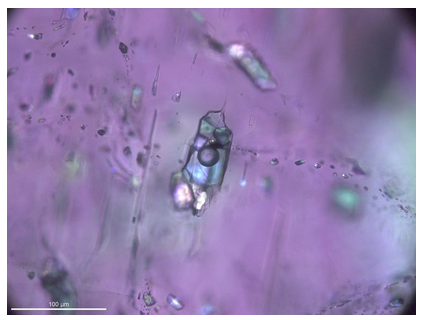8.2.4: Metamorphic Fluids
- Page ID
- 18607

Metamorphism often involves fluids, most commonly water-rich but sometimes dominated by carbon dioxide, sulfur, or other components. Many mineral grains contain fluid inclusions that have trapped samples of fluids that once flowed through them. Figure 8.22 shows a fluid inclusion that contains liquid, gas bubbles, and minerals that crystallized from the trapped fluid. The color is an artifact of the way the photo was taken.
Metamorphic fluids may be magmatic (expelled by magmas as they crystallize), meteoric (derived from precipitation that infiltrates the ground), released during subduction of wet lithosphere, or products of reactions that release H2O or CO2 from minerals. Hydrothermal metamorphism occurs when warm fluids significantly alter protolith rocks. This kind of metamorphism can affect large areas and be part of regional metamorphism, or it can be localized and part of contact metamorphism. In either case, the metamorphism involves hot, generally water-rich fluids that flow through cracks and along grain boundaries. The fluids act as catalysts and fluxes that promote reactions and large crystal growth. More important, the fluids may cause metasomatism that changes the composition of the protolith by adding or removing specific elements. The resulting rock may be of a much different composition than its parent. Metasomatism creates many kinds of products. It can, for example, create ore deposits by concentrating minerals (most commonly copper, iron, or lead sulfides) in host rocks where they did not exist previously.


